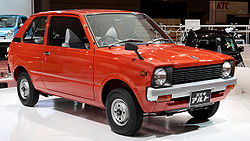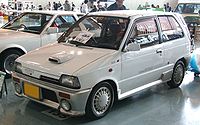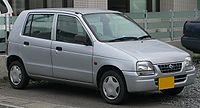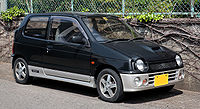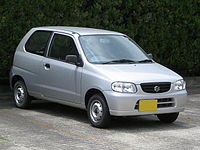- Suzuki Alto
-
Suzuki Alto 
Manufacturer Suzuki Also called Suzuki Mehran
Suzuki Hatch
Maruti 800
Maruti Alto
Daewoo Tico
Nissan Pixo
Suzuki Cervo
Suzuki Cervo ModeProduction 1979–present Class Kei car
City carBody style 3-door hatchback
3-door Van
4-door sedan
5-door hatchbackThe Suzuki Alto is a small car (kei car) designed by Suzuki. Its selling points include low price and good fuel economy. The model was introduced in 1979 and has been built in many countries worldwide.
Contents
1st generation (SS30/40)
Suzuki Alto
1979 Alto SS30V (van)Manufacturer Suzuki Also called Suzuki Fronte
Suzuki Hatch
Maruti 800Production 1979—1984 Layout Transversal front engine,
FWD or part-time 4WDEngine 539 cc T5B two-stroke I3
543 cc F5A SOHC I3The 1st generation (SS30V/40V), introduced in May 1979, was a 3-door cargo version of the Fronte passenger car, equipped with a folding rear seat. On introduction, the Alto received the T5B two-stroke 539 cc (SS30) three-cylinder engine, producing 28 PS (21 kW) at 5,500 rpm. The Alto was a "micro sensation" when introduced, largely due to its rock bottom price of ¥470,000 (circa $1,900 in 1979, at a time when the cheapest Ford Pinto cost $4,999). This bargain price was made possible by a number of Japanese special concessions for commercial vehicles: The engine did not require twin catalysts, unlike in the Fronte. Two less doors provided another saving, as did the exemption from commodity tax. The Alto was a sensation, and other producers such as Subaru (with the "Family Rex") quickly followed suit.[1]
In January 1981, the F5A four-stroke 543 cc known from the Fronte was also installed (though with only a single-barrel carburettor), it too put out 28 PS (21 kW) but at 6,000 rpm. Torque was considerably lower, down from 5.3 kg·m (52 N·m; 38 lb·ft) to 4.2 kg·m (41 N·m; 30 lb·ft).[2] 1981 saw also the year that it became available on the United Kingdom market, as Suzuki began selling cars there that year.
In export markets, the Alto name was used for the passenger car versions (chassis codes with trailing letter "S") as well as on commercials (ending in"V"), while the van was marketed as the "Suzuki Hatch" in Australia. The four-doors were not proper hatchbacks, only featuring an opening rear window. Export cars were also available with twelve-inch wheels, unlike the domestic versions which only used ten-inch units until the introduction of the 4WD version in October 1983. The 4WD "Snow Liner" thus gained an extra 2.5 cm (1 in) of ground clearance.[3]
While Suzuki held on to the two-stroke engine concept for a half decade longer than any of its Japanese competitors, eventually market pressures and ever tightening emissions regulations spelled its end in the Alto by September 1981. The Jimny, however, did use the same 539 cc engine (called LJ50 in the Jimny) as late as 1987.
2nd generation (CA71)
Suzuki Alto 
Alto "Juna" Special Edition CA72Manufacturer Suzuki Also called Maruti 800
Suzuki MehranProduction 1984-1988
(until 1993 for Europe)Engine 543 cc F5A I3
796 cc F8B I3Transmission 4/5-speed manual
2/3-speed automaticRelated Chang'an SC7080 Alto/City Baby
JN Auto (CN)
Iran Khodro Alto (IR)
Peugeot JN Mini (TN)The 2nd generation (CA71) was introduced in September 1984. It continued with the SS40's F5A engine, but also became available with turbocharged and multi-valve engines thereof, mainly in the "Works" series. In December 1984 a 4-wheel drive version (CC71) was added. Performance versions of the Alto first appear in 1985 when a turbocharged engine was made available. It gradually acquired more performance-related modifications until the Works version was introduced in February 1987. The Alto Works was the first kei-car to reach the legal limit of 64 PS (47 kW). It acquired considerable popularity, with models of it still made by Fujimi. A 5-door body (identical to the Fronte's) became available in October 1985.
In July 1986 the CA/CC71 became the CA/CC72 after a rather thorough facelift. New wraparound headlights, a new dash and interior heralded the new ITL rear suspension (Isolated Trailing Link), a three-link rigid setup. A "Walkthrough Van" was introduced in January 1987, while at the other end of the spectrum, the personal coupé Cervo on the CA/CC72 base was introduced in 1988 with a new 547 cc F5B engine. In August 1987, higher spec Altos became available with a 3-speed automatic rather than the 2-speed they had been using before.
Other markets
Europe
The 796 cc, 40 hp (30 kW) F8B-engined CA/CB91 was sold in Europe with either a 4-speed manual or 2-speed automatic transmission. Export Altos were technically speaking Frontes, as this was the name used for passenger versions in Japan. They received larger bumpers, making them 105 mm (4.1 in) longer and 10 mm (0.4 in) wider. European Altos received the same facelift as the CA/CB72 did in January 1988, unveiled at the Brussels Motor Show.[4] This model remained in production (latterly by Maruti Udyog) for the European market until 1993, when it was replaced by an also Maruti-built 1-litre version of the Cervo Mode.
India and Pakistan
For the Indian-built Altos (Frontes), see Maruti 800.This generation of the Alto/Fronte still remains in production in India and Pakistan. While the Indian Maruti 800 version utilizes a 796 cc MPFI F8B engine, the Pakistani Suzuki Mehran still uses the 1980s era carburated version.
China
In 1988 production began in China, in cooperation with Chang'an Motors. The Chang'an Suzuki SC7080 Alto was produced with the same F8B engine as used in other export markets, and was replaced by the facelifted SC7081 Alto/City Baby/Little Prince/Happy Prince in 2001. The top of the Line Happy Prince, discontinued in 2007, used the sportier looking front bumper, grille, and bonnet of the Alto Works. Another version called JN Auto(German) is built by Jiangnan since 1992 and is still in production for the Chinese, Central and South American markets, although now it is called the 'Zotye JN Auto'.[5] As of Dec, 2010 Zotye's Jiangnan Alto is the cheapest car in the world, with a tag price of $2,830.[6] The entry-level model comes with the 796 cc F8B three-cylinder 36 PS (26.5 kW).[citation needed] A four-cylinder with a displacement of 1,051 cc and an output of 52 PS (38.5 kW) is also available. A version of the Jiangnan Alto was assembled until 2005 in Tunisia for African markets, labelled "Peugeot JN Mini".
3rd generation (CL11)
Suzuki Alto 
1992 Alto CR22 5-doorManufacturer Suzuki Production 1988-1994 Engine 547 cc F5B I3
657 cc F6A I3Transmission 4/5-speed manual
3-speed automaticThe 3rd generation (CL/CM11) replaced the CA71 in September 1988. This was the last generation of Alto to have an associated Fronte model. It had strikingly angular styling, with an unusual glazed C-pillar on the 5-door. Another curiosity of this generation was the availability of a version with sliding doors, the "Slide Slim", intended to simplify entering and exiting in tight spaces. It also made egress easier for the old and the infirm. When the Fronte name was discontinued in October 1989, the passenger car versions (CN/CP11) became Altos. Initially the CL11 used the 12-valve 42 hp (31 kW) F5B engine known from the SS71 Cervo, but with an added 34 hp (25 kW) 6-valve version in lower-spec versions. A 46 hp (34 kW) DOHC version was also available in the Twin Cam Rl. Passenger car versions had the same engines, but all with 2 hp less due to more stringent emissions controls. The fuel-injected, 12-valve, turbocharged Works models came with an SOHC 58 hp (43 kW) engine (FF S/X or 4WD S/R) or a 64 hp (48 kW) DOHC version (FF RS/X or 4WD RS/R). The front-wheel drive Works' were available with a 3-speed automatic in addition to the standard 5-speed manual.[7]
660cc era
Alto/Works
When the Kei car standards were changed in 1990, capacity was increased to 657 cc (F6A) in March, the Alto becoming the CL/CM/CN/CP21 in the process. The new standards also allowed for a 100 mm (3.9 in) longer car, which meant new bigger front and rear bumper, and new headlights and grille. Lower grade Van versions received a 6-valve 36 hp (27 kW) engine, while passenger car versions (and the l'Èpo Van) got a 12-valve, 52 hp (39 kW) version. 4WD versions with the 3-speed automatic transmission were fuel-injected and offered 3 more hp. The F6A-engined Works RS/X and RS/R still claimed the legally limited 64 hp, but the lower grade i.e. Turbo (introduced in July) received a 6-valve SOHC-engine producing 61 hp (45 kW).[7] Reflecting decreased tax benefits for commercial Kei cars, the Works series was now classified as passenger vehicles, allowing for a real backseat.
In September 1991, responding to increasing safety demands, the Alto received side impact protection. Also, the vertical door handles (see picture on the right) on three-door versions were replaced by traditional horizontal ones. The reengineering was extensive enough to necessitate new model codes, with vans becoming CL/CM22 (FF/4WD) and passenger versions (including the Works) now called CR/CS22. While performance engines remained as they were, the "cooking" Alto's engines were updated with power outputs up to 40 and 52 hp respectively (29/38 kW).[8]
Alto Hustle
Suzuki also produced a version (the Hustle) with a high roof behind the front seats, which was unusual in that it used a modification of the 5-door Alto's body rather than a completely new body; this made it possible to link the Hustle with the Alto, but made the styling rather unharmonious. Its appearance was similar to the Nissan AD Max van. It was short-lived, only being offered between November 1991 and October 1993.
Table data is from Goo-net,[9] unless otherwise specified. ( · )=AT version, [ · ]=MT 4WD, { · }=AT 4WD
Suzuki Alto Hustle 1991-93 Version Hu-2 Hu St Le Empty Weight 630 kg 640 (650) [690] kg 660 (670) kg 660 (670) [710] {730} kg Wheelbase 2,335 mm (91.9 in) Track front: 1220 mm (48.0 in), 4WD: 1215 mm (47.8 in)
rear: 1200 mm (47.2 in)Length/Width/Height 3295 / 1395 / 1660 mm (4WD: 1685)
129.7 / 54.9 / 65.4 in (4WD: 66.3)Seats 2 4 Engine All alloy SOHC 657 cc inline-three F6A, 65.0 x 67.0 mm Valvetrain 2 valves per cylinder (6-valve) 4 valves per cylinder (12-valve) Aspiration single-barrel carburator EPI (electronic fuel injection) Power 40 PS (29 kW) at 6,000 rpm 52 PS (38 kW) at 7,000 rpm 55 PS (40 kW) at 7,500 rpm Torque 5.5 kg·m (54 N·m; 40 lb·ft) at 4,500 rpm 5.7 kg·m (56 N·m; 41 lb·ft) at 4,500 rpm 5.8 kg·m (57 N·m; 42 lb·ft) at 5,500 rpm Compression 9.7:1 10.5:1 Top speed 120 km/h (75 mph)[10] 140 km/h (87 mph)[10] 150 km/h (93 mph)[10] Fuel tank size 30 L (6.6 imp gal; 7.9 US gal) Tires 135/80SR12 135/80SR12
(4WD: 155/70R12 73S)135/80SR12 135/80SR12
(4WD: 155/70R12 73S)4th generation (HA11)
Suzuki Alto 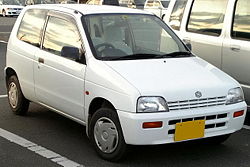
1994 AltoManufacturer Suzuki Also called Chang'an SC7080 City Baby Production 1994-1998 Engine 657 cc F6A I3
658 cc K6A I3The 4th generation (HA11) appeared in 1994. The 657 cc F6A engines were joined by a new high-performance 64 PS (47 kW) 658 cc K6A (HA21). The styling displays an interesting blend of features: the tailgate and rear doors are still fairly angular, but the front is beginning to be more rounded - a trend which would be continued in later years.
5th generation (HA12)
Suzuki Alto
Suzuki Alto Lc HA12Manufacturer Suzuki Also called Chang'an SC7090 Zen Production 1998-2005 Engine 657 cc F6A I3
658 cc K6A I3Transmission 4/5-speed manual
3/4-speed automatic
CVTWheelbase 2,360 mm (92.9 in) Length 3,395 mm (133.7 in) Width 1,475 mm (58.1 in) Height 1,440–1,455 mm (56.7–57.3 in) Curb weight 630–800 kg (1,400–1,800 lb) The 5th generation Alto (HA12/22) was introduced in October 1998. The styling was generally more rounded, the shape of the cabin showing the Alto's relationship with the new Suzuki Kei. The 658 cc K6A engine was now also available without a turbocharger, joining the turbocharged version and the familiar 657 cc F6A engines. The turbocharged Works models were available with a 60 hp F6A engine (i.e., 5MT/3AT and FF or 4WD) or a 64 hp VVT K6A (RS/Z, 5MT and FF or 4WD). The front wheel drive RS/Z was sold with a non-VVT K6A engine when in combination with a 4-speed automatic transmission, it too with a claimed 64 hp. In December 2000, the Works versions were discontinued, as the Alto was realigned as an economy version. The Suzuki Kei Sports picked up the Works' mantle.
Several derivatives were produced from this generation. Suzuki produced two "classic-style" versions: the Alto C [11] with a deep chrome grille and a curious headlamp arrangement by which circular main lamps were joined with ovoid sidelights and indicators, which was shared with the Alto Works;[12] and the Alto C2 [13] which had separate headlamps and sidelights and a wider grille. Mazda also sold the standard Alto as the Carol, and Mitsuoka used the Carol as a basis for their Ray. Pakistani production began in 2000,[citation needed] utilizing the F10A engine.
Facelift
In December 2000, the fifth generation Alto received a thorough facelift, becoming the HA23. As the Works was discontinued, naturally aspirated versions of the K6A became the only ones on offer, with either 54 hp (40 kW) or 46 hp (34 kW) in an especially efficient lean-burn iteration. Front- or four-wheel drive, manual and automatic transmissions were available (no more CVT), in either a 3- or 5-door hatchback body. A 3-door van version remained available.[14]
Maruti Alto
Maruti Alto 
Manufacturer Maruti Suzuki India Ltd Production 2000–present Predecessor Maruti 800 Successor Maruti Suzuki A-STAR Class Subcompact Body style 5-door hatchback Layout FF layout Engine 796 cc F8D I3
998 cc K10B I3
1,061 cc F10D I4Transmission 5-speed manual Wheelbase 2,360 mm (92.9 in) Length 3,495 mm (137.6 in) Width 1,475 mm (58.1 in) Height 1,460 mm (57.5 in) Kerb weight 720 kg (1,587 lb) (Kerb) Related Maruti Suzuki A-Star
Suzuki AltoThe Maruti Alto is the Indian-built version of the fifth generation Alto, manufactured by Maruti Suzuki. It was launched in the local Indian market on September 27, 2000[15] although the Alto nameplate was very successfully being used to export the Maruti Zen to Europe from India since around 1994[16] having captured over 40% market share in Belgium and 33% in Netherlands by 1998.[17] It is the best-selling hatchback in India.[15] Since 2006, It is India's largest selling car[18] and crossed the 1 million production figure in February 2008 becoming the 3rd Maruti model to cross the million mark in India after Maruti 800 and Maruti Omni and 4th overall joining Hyundai Santro.[19] Besides being exported to Europe from 1994–2004, it has also been exported to several other countries.
Specifications
Until the late 2010 introduction of the K10 Alto, it was powered by a three-cylinder 796 cc gasoline engine with 4 valves per cylinder, MPFI and a 32bit ECM. All models have a five-speed manual transmission. There also used to be a VX/VXi model with a 4-cylinder 1,061 cc engine (64 bhp/80 Nm torque) launched in April 2001. This has now been discontinued, although it is still sold in certain European countries. The VX model also featured a tachometer not found in lesser Altos.
800 cc Alto:
- Maximum Power: 47 PS (35 kW) at 6,200 rpm
- Torque: 62 N·m (46 ft·lbf) at 3,000 rpm
- Acceleration 0–100 km/h: approximately 20 seconds
- Top Speed: 137 km/h (85 mph)[citation needed]
Variants

Maruti Alto rear viewThe Alto is offered in the following variants:[20]
Maruti Alto Models in India[21] Standard Base model, non-AC, launched in 2004.[22] LX Upgraded, with AC, tinted windows, heater, floor front console with cup holders, fabric seats, etc. LXi High-end, with extra features like integrated rear seat head restraints, remote fuel lid opener, electronic power steering, etc. The Alto was seen as a natural successor to the time-tested and equally popular Maruti 800 (MB 308). It contained all the plus points that the 800 offered Indian car-buyers, in addition to features such as power-steering, power-assisted braking and a 5th gear that the 800 did not normally have. The popularity of the Alto has steadily increased over the past few years, mainly due to the aggressive pricing. This reduction in prices has mainly come in due to the reduction in excise duty over time. Alto became the first car in India to sell over 200,000 units in a single financial year, the last 100,000 units being sold in 5 months. Alto was also the only car to sell over 22,000 units in a single month. Maruti's vast network of dealerships and Maruti Authorized Service Centers (MASS) have also contributed towards this massive popularity in the Indian entry-level automobile market.
Maruti Alto with K Series Engine[23] Maruti Suzuki has launched a new version of Maruti Alto in the Indian auto market in August 2010. The new Maruti Alto K10 is equipped with the company's 1.0 L, K-series petrol engine which also currently powers the A-Star and Wagon R. The K10B engine delivers 68 PS (50 kW) of maximum power at 6,200 rpm with 90 Nm of maximum torque at 3,200 rpm. 0–100 km/h is possible in 13.33 seconds.[citation needed] The company's senior official said that they have no plans to discontinue the previous version with the launch of Maruti Alto.
6th generation (HA24)
Suzuki Alto 
2006 Alto HA24SManufacturer Suzuki Also called Chevrolet Alto
Maruti-Suzuki Alto
Mazda Carol
Nissan PinoProduction 2004—2009 The 6th generation (HA24) was introduced in 2004. The bonnet and headlamps curved down at the front, giving a similar effect to the Toyota WiLL Vi or the Citroën C2. The Alto was re-aligned as a less costly car to accommodate new models such as the Cervo and Alto Lapin. The more powerful engines were moved into the other more upmarket versions like the Suzuki Kei Works and Alto Lapin SS, leaving the Alto with only a 54 PS (40 kW) version. In Japan, this version of the Alto was rebadged as the Nissan Pino and Mazda Carol.
7th generation (2009-present)
Japan
Suzuki Alto 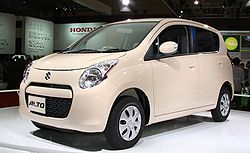
Manufacturer Suzuki Also called Mazda Carol Class Kei car Body style 5-door hatchback Layout FF
4WDEngine 658cc petrol Transmission 5-speed manual
4-speed automatic
CVTWheelbase 2,400 mm (94.5 in) Length 3,395 mm (133.7 in) Width 1,475 mm (58.1 in) Height 1,535 mm (60.4 in) The 7th Generation was first shown at the 2009 Tokyo Motor Show alongside its sister car, the Mazda Carol.
International
Maruti Suzuki A-Star 
Manufacturer Maruti Suzuki Also called Suzuki Alto
Suzuki Celerio
Changhe-Suzuki Alto
Nissan PixoAssembly Manesar, Haryana, India Predecessor Maruti Alto Class City car Body style 5-door hatchback Engine 1.0 L K10B I3 Transmission 5-speed manual
4-speed automaticWheelbase 2,360 mm (92.9 in) Length 3,580 mm (140.9 in) Width 1,680 mm (66.1 in) Height 1,400 mm (55.1 in) The 7th Generation is known in India as the Maruti Suzuki A-Star (short for "Alto-Star"), but is also known as the Suzuki Celerio in some other countries. It was launched in December 2008 by the Indo-Japanese auto maker Maruti Suzuki. The car is manufactured exclusively in Haryana, India and is exported worldwide. It is available in European markets with a somewhat different front end as the Nissan Pixo. The car was rolled out to the Indian customers in December 2008 and exports began in April 2009. The Indian market version comes in three variants - LXi, VXi and ZXi.
The initial expected prices in the Indian market are
 3.45 lakh (US$6,996.6) (ex-showroom Delhi) for the LXI,
3.45 lakh (US$6,996.6) (ex-showroom Delhi) for the LXI,  3.72 lakh (US$7,544.2) for the VXI and
3.72 lakh (US$7,544.2) for the VXI and  4.06 lakh (US$8,233.7) for the ZXI. With this price tag, the car is targeted at customers with budgets somewhere between the Zen Estilo and the Swift.
4.06 lakh (US$8,233.7) for the ZXI. With this price tag, the car is targeted at customers with budgets somewhere between the Zen Estilo and the Swift.With a totally new body and engine, Maruti hopes to bring freshness to the Indian car market, of which it already holds a major share. The 998 cc three cylinder K10B was developed especially for the new car, and is also used for the Nissan Pixo. Initial reviews have been positive. The A-Star has a fresh new dashboard, with an available unique protruding tachometer besides the usual meter cowl (only in the ZXi trim). Along with the Swift, SX4 and Grand Vitara, the A-Star is part of an effort to change Suzuki/Maruti's reputation into that of being a producer of stylish cars.
Nissan Pixo
The Nissan Pixo, available in Europe since 2009 is the "sister car" to the Suzuki Alto featuring a few obvious differences, including the main grille and headlamps. Because it is developed and built in low-cost India, the Pixo can be bought new for just under £7,000[24] and nearly a third of that price for a used one.[25]
The main competitors are the Toyota Aygo, Kia Picanto and Renault Twingo, all also small hatchbacks but all offering more luggage space than the Pixo.
- Trim Variants/Engines
The UK has 4 different trims available for the Pixo: N-Tec, Visia, Acenta and Tekna, all available with a 1.0 L Suzuki K10B three-cylinder petrol engine - shared with the Alto and capable of 68 hp (51 kW) and a top speed of 155 km/h (96 mph), reaching 100 km/h in 13.5 seconds. All are five door hatchbacks, with the option of a 4-speed automatic or 5-speed manual gearbox, except the Visia, which is only available with the manual gearbox.
Export markets
Early exports were usually Frontes, as the Alto nameplate was only used on commercial versions in Japan, exported with few changes apart from enlarged engines, sometimes modified bodywork and various different names. Thus the SS40 Fronte became the SS80 Alto with a 796 cc engine. However, as Suzuki made agreements with companies such as Maruti to build their models, it began to be possible to sell different models to different areas:
- The CA71 is made with the 796-cc engine in India as the Maruti 800, in Pakistan by Pak Suzuki as the Mehran 800, and in China by (among others) Chang'an, Jiangbei and Jiangnan. This model, rather than the CL11, was exported to Europe until 1994.
- The CL11 was made in Korea, Poland, Romania and Uzbekistan as the Daewoo Tico, and in China by Anchi.
- In 1994 the CA71 Alto was replaced for European consumption by the Maruti-built version of the Cervo Mode, which was sold as the Alto until 2002.
- The HA12 is made in India as the Maruti Alto (in a longer and wider form with 796 or 1,061 cc engines, with five doors), and this was exported to Europe as the Suzuki Alto from 2002 until 2009. It is also made by Pak Suzuki in Pakistan, and was formerly made by Chevrolet in Colombia.
- The current Alto is exported from India with a 998 cc engine producing 65 PS (48 kW).
Thus the European Suzuki Altos are really:
- 1979-84: SS40 Frontes with a 40 hp (30 kW) 796 cc 3-cylinder engine (SS80).
- 1984-94: CA/CB91 Altos/Frontes (also referred to as SB308) with the same 40 hp (30 kW) F8B engine as the SS80.
- 1994-2002: Maruti Zens (based on the Cervo Mode), with a 993 cc engine.
- 2002-2009: Maruti Altos (based on the HA12 Alto), with a 1,061 cc engine.
- 2009 to date Maruti Suzuki A-Star, with a 998 cc engine.
The Suzuki Alto European market version of the Maruti Suzuki A-Star was unveiled at the 2008 Paris Motor Show. It was developed to be a global car and will be made at Maruti Suzuki's plant in Manesar, Haryana, India. It is stylistically based on the Suzuki A-Star Concept.[26] The Alto was conceived as a response to high petrol prices and global warming. The vehicle's emissions will be only 103g of CO2/km. It will be an eco-friendly car priced from £6,795 OTR.[27] The Maruti Suzuki A-Star is also produced for Nissan, its version is called Nissan Pixo.
The GoGet car share scheme provides 2009 model Suzuki Altos as part of its fleet of share cars in Australia. The locally-made versions of the various Altos have had long production lives, and have sometimes won great popularity, as with the Maruti 800. In particular the CA71 generation has been produced in many countries, and can frequently be seen being offered as a cheap city car among several more newly-designed products.
References
- ^ Yamaguchi, Jack K. (1980), Lösch, Annamaria, ed., "Consummation of the Turbulent Decade", World Cars 1980 (Pelham, New York: L'Editrice dell'Automobile LEA/Herald Books): 66–67, ISBN 0-910714-12-6
- ^ (in Japanese) Car Graphic: Car Archives Vol. 11, '80s Japanese Cars, Tokyo: Nigensha, 2007, p. 261, ISBN 978-4-544-91018-6
- ^ Nakamura, Takahito, and Piazzi, Filippo (July–September 1984). Marin, Gianni. ed. (in Italian)Auto in Fuoristrada (Milan: Rusconi Editore) 3 (7): 55.
- ^ Quattroruote: Tutte le Auto del Mondo 1992. Milano: Editoriale Domus S.p.A. 1992. pp. 974–976.
- ^ "Zotye to Challenge Tata Nano with a $2,765 Alto". ChinaAutoWeb.com. http://chinaautoweb.com/2010/08/zotye-to-challenge-tata-nano-with-a-2765-alto/.
- ^ "Jiangnan Alto, China's Cheapest Car from Zotye, Beats Tata Nano". ChinaAutoWeb.com. http://chinaautoweb.com/2010/11/jiangnan-alto-chinas-cheapest-car-from-zotye-beats-tata-nano/. Retrieved 2010-01-13.
- ^ a b "Alto". U's Station On the Net - Short Catalog by Model. Suzuki Motor Corporation. Archived from the original on 2010-07-13. http://www.suzuki-w.co.jp/history2/alto/altkeifu.html.
- ^ "Goo-net Catalog: Suzuki Alto 1991年9月". Goo-net. Archived from the original on 2010-07-13. http://www.goo-net.com/catalog/SUZUKI/ALTO/index.html#199109.
- ^ "Goo-net Catalog: Suzuki Alto Hustle". Goo-net. Archived from the original on 2010-07-13. http://www.goo-net.com/catalog/SUZUKI/ALTO_HUSTLE/index.html.
- ^ a b c Quattroruote: Tutte le Auto del Mondo 1992. Milano: Editoriale Domus S.p.A. 1992. pp. 978–980.
- ^ "Suzuki Alto C pictures 1999". English.auto.vl.ru. http://english.auto.vl.ru/catalog/suzuki/alto_c/1999_10/photo/. Retrieved 2011-04-04.
- ^ "Suzuki Works pictures 1998". English.auto.vl.ru. http://english.auto.vl.ru/catalog/suzuki/works/1998_10/photo/. Retrieved 2011-04-04.
- ^ "Suzuki Alto C2 pictures 2001". English.auto.vl.ru. http://english.auto.vl.ru/catalog/suzuki/alto_c2/2001_2/photo/. Retrieved 2011-04-04.
- ^ "Alto HA23S HA23V". U's Station On the Net - Short Catalog by Model. Suzuki Motor Corporation. Archived from the original on 2010-07-14. http://www.suzuki-w.co.jp/history2/alto/altHA23X.html.
- ^ a b "Maruti Alto crosses one million units". Maruti Suzuki India Limited. 2008-02-14. http://www.marutisuzuki.com/Maruti-Alto-crosses-one-million-units.aspx. Retrieved 2009-01-26.
- ^ "Maruti's exports cross half a million". The Hindu Business Line. 2008-02-28. http://www.blonnet.com/2008/02/29/stories/2008022951730300.htm. Retrieved 2009-01-26.
- ^ "Maruti to decide on another price hike soon: MD". Indian Express. 1998-06-04. http://www.indianexpress.com/res/web/pIe/ie/daily/19980605/15650264.html. Retrieved 2009-01-26.
- ^ "Maruti Alto is India's highest selling car". domain-b.com. 2006-11-02. http://www.domain-b.com/companies/companies_m/maruti/20061102_highest_selling.htm. Retrieved 2009-01-26.
- ^ "The Continental Divide: The Most Popular Cars by Continent". Automotoportal.com. http://www.automotoportal.com/article/the-continental-divide-the-most-popular-cars-by-continent. Retrieved 2011-09-17.
- ^ "Alto". Maruti Suzuki India Limited. http://www.marutialto.com/Variants.asp. Retrieved 2009-01-26.[dead link]
- ^ CarDekho (2010-07-30). Maruti Alto India
- ^ "Maruti launches Alto Variant". Financial Express. 2004-04-09. http://www.financialexpress.com/news/maruti-launches-alto-variant/103728/. Retrieved 2009-01-26.
- ^ Economic Times (2010-07-30). Maruti Alto K10 Launch
- ^ "New Nissan Pixo Car Review". Parkers. http://www.parkers.co.uk/cars/reviews/nissan/pixo-2009.aspx. Retrieved 2011-09-17.
- ^ "New Nissan Pixo Car Review - Facts & Figures". Parkers. http://www.parkers.co.uk/cars/reviews/nissan/pixo-2009.aspx?page=7. Retrieved 2011-09-17.
- ^ Tan, Paul. "New Suzuki Alto images released, details to come". Paultan.org. http://paultan.org/archives/2008/08/08/new-suzuki-alto-images-released-details-to-come/. Retrieved 2011-09-17.
- ^ "Suzuki Alto - The Newest Eco Friendly Car". Motoring-blog.com. 2008-08-21. http://www.motoring-blog.com/2008/08/21/suzuki-alto-newest-eco-friendly-car/. Retrieved 2011-09-17.
External links
- Suzuki Japan's Alto page (Japanese)
- Official page for Maruti 800
- Official page for Maruti A-Star
- History of Suzuki kei cars
- Maruti Suzuki Alto K10
- Maruti A-STAR Launched
- Official Nissan Pixo website
- Suzuki Alto review
Suzuki/Suzulight road car timeline, 1955-1989 Type 1950s 1960s 1970s 1980s 5 6 7 8 9 0 1 2 3 4 5 6 7 8 9 0 1 2 3 4 5 6 7 8 9 0 1 2 3 4 5 6 7 8 9 Kei sedan Suzulight SS Suzulight Fronte Fronte 360 Fronte
71/72/NewFronte LC20 Fronte 7-S Fronte Fronte Fronte Kei Sports Fronte Coupé Cervo/SC100 Cervo Cervo Kei light commercial Suzulight SL/SD/SP Suzulight 360 Van Fronte Van/ Estate/Custom Fronte Hatch Alto Alto Alto Kei truck Mighty Boy Suzulight Carry FB (Suzulight) Carry L20, L30 Carry L40 Carry L50/L60 Carry 55/Wide Carry ST30/40 Carry Kei van Suzulight Carry Van FBD (Suzulight) Carry Van L20, L30 Carry Van L40 Carry Van L50/L60 Carry Van 55/Wide Carry Van/Every Every Microvan ST80 ST90 SuperCarry Subcompact Fronte 800 SA310/Cultus Cultus Kei SUV Jimny, Jimny55 Jimny550 Mini SUV Jimny8, LJ80 Jimny1000, SJ410 Jimny1300, SJ413, Samurai Escudo Categories:- Suzuki vehicles
- Kei cars
- Front wheel drive vehicles
- Vehicles introduced in 1979
- Hatchbacks
- Maruti vehicles
- Subcompact cars
Wikimedia Foundation. 2010.

